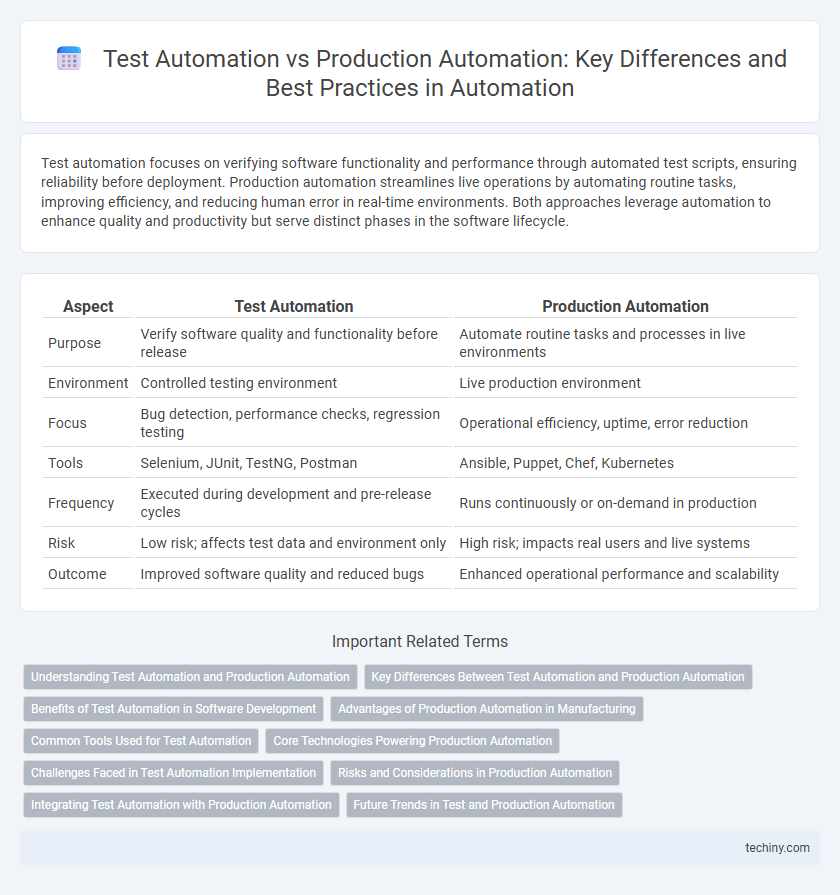Test automation focuses on verifying software functionality and performance through automated test scripts, ensuring reliability before deployment. Production automation streamlines live operations by automating routine tasks, improving efficiency, and reducing human error in real-time environments. Both approaches leverage automation to enhance quality and productivity but serve distinct phases in the software lifecycle.
Table of Comparison
| Aspect | Test Automation | Production Automation |
|---|---|---|
| Purpose | Verify software quality and functionality before release | Automate routine tasks and processes in live environments |
| Environment | Controlled testing environment | Live production environment |
| Focus | Bug detection, performance checks, regression testing | Operational efficiency, uptime, error reduction |
| Tools | Selenium, JUnit, TestNG, Postman | Ansible, Puppet, Chef, Kubernetes |
| Frequency | Executed during development and pre-release cycles | Runs continuously or on-demand in production |
| Risk | Low risk; affects test data and environment only | High risk; impacts real users and live systems |
| Outcome | Improved software quality and reduced bugs | Enhanced operational performance and scalability |
Understanding Test Automation and Production Automation
Test Automation involves using specialized software tools to execute pre-scripted tests on applications to verify functionality, performance, and security, thereby improving the quality and reliability of software before release. Production Automation focuses on automating operational workflows, system monitoring, and maintenance tasks within a live production environment to enhance efficiency, reduce errors, and ensure continuous service availability. Understanding the distinct roles of Test Automation in software validation and Production Automation in operational management is crucial for optimizing development and deployment pipelines.
Key Differences Between Test Automation and Production Automation
Test automation focuses on verifying software functionality, performance, and security before deployment, using tools like Selenium and JUnit to execute repeatable test cases efficiently. Production automation involves eliminating manual intervention in live environments by automating workflows, monitoring, and incident response with platforms such as Kubernetes and Ansible. The key differences lie in their objectives--test automation ensures quality assurance pre-release, whereas production automation optimizes operational efficiency and reliability post-deployment.
Benefits of Test Automation in Software Development
Test automation enhances software development efficiency by enabling consistent and repeatable execution of test cases, which reduces manual effort and accelerates the identification of defects. It improves test coverage and reliability, ensuring that code changes are validated quickly and thoroughly before production deployment. Leveraging automated testing frameworks also supports continuous integration and continuous delivery (CI/CD) pipelines, resulting in faster release cycles and higher software quality.
Advantages of Production Automation in Manufacturing
Production automation in manufacturing significantly enhances operational efficiency by enabling continuous, high-speed production with minimal human intervention. It reduces error rates and ensures consistent product quality through precise control and real-time monitoring systems. The integration of robotics and IoT technologies in production automation also lowers labor costs while increasing scalability and adaptability to changing market demands.
Common Tools Used for Test Automation
Common tools used for test automation include Selenium, Appium, and JUnit, which enable automated testing of web and mobile applications across various browsers and platforms. Frameworks like TestNG and Cucumber support integration and behavior-driven development, improving test coverage and maintainability. These tools facilitate continuous integration and delivery by automating repetitive testing tasks, enhancing software quality before production deployment.
Core Technologies Powering Production Automation
Core technologies powering production automation include Industrial Internet of Things (IIoT) devices, programmable logic controllers (PLCs), and advanced robotics enhanced by AI and machine learning algorithms. These technologies enable real-time data collection, predictive maintenance, and autonomous decision-making, significantly improving operational efficiency and reducing downtime. Integration with cloud computing and edge devices ensures scalable, secure, and flexible production environments optimized for continuous improvement and rapid adaptation.
Challenges Faced in Test Automation Implementation
Test automation faces significant challenges, including script maintenance due to frequent application changes and high initial setup costs requiring skilled resources. Ensuring test reliability is difficult because flaky tests often generate false positives or negatives, undermining confidence in results. Integration with continuous integration/continuous deployment (CI/CD) pipelines also demands careful configuration and robust tooling to avoid delays in the release cycle.
Risks and Considerations in Production Automation
Production automation involves higher risks including system failures that can directly impact end-users and business continuity, making rigorous monitoring and fail-safe mechanisms essential. Unlike test automation, production automation requires stringent security protocols to prevent data breaches and unauthorized access during real-time operations. Careful consideration of scalability, compliance, and disaster recovery plans is critical to mitigate potential disruptions and ensure stability in automated production environments.
Integrating Test Automation with Production Automation
Test Automation ensures software reliability by executing predefined test cases automatically to identify defects early, while Production Automation streamlines live operational workflows for efficiency and scalability. Integrating Test Automation with Production Automation creates a continuous feedback loop, enabling real-time validation of system performance and reducing downtime through proactive error detection. This synergy enhances overall system robustness, accelerates deployment cycles, and supports adaptive maintenance in dynamic production environments.
Future Trends in Test and Production Automation
Test automation is evolving with AI-driven tools that enhance test accuracy and accelerate regression testing cycles, while production automation increasingly adopts IoT and edge computing to optimize real-time decision-making and predictive maintenance. Future trends indicate a convergence where intelligent automation frameworks integrate continuous testing within continuous deployment pipelines, ensuring seamless quality assurance throughout the software development lifecycle. Emphasis on cloud-native automation platforms and machine learning algorithms is expected to drive adaptive, self-healing systems in both test and production environments.
Test Automation vs Production Automation Infographic

 techiny.com
techiny.com